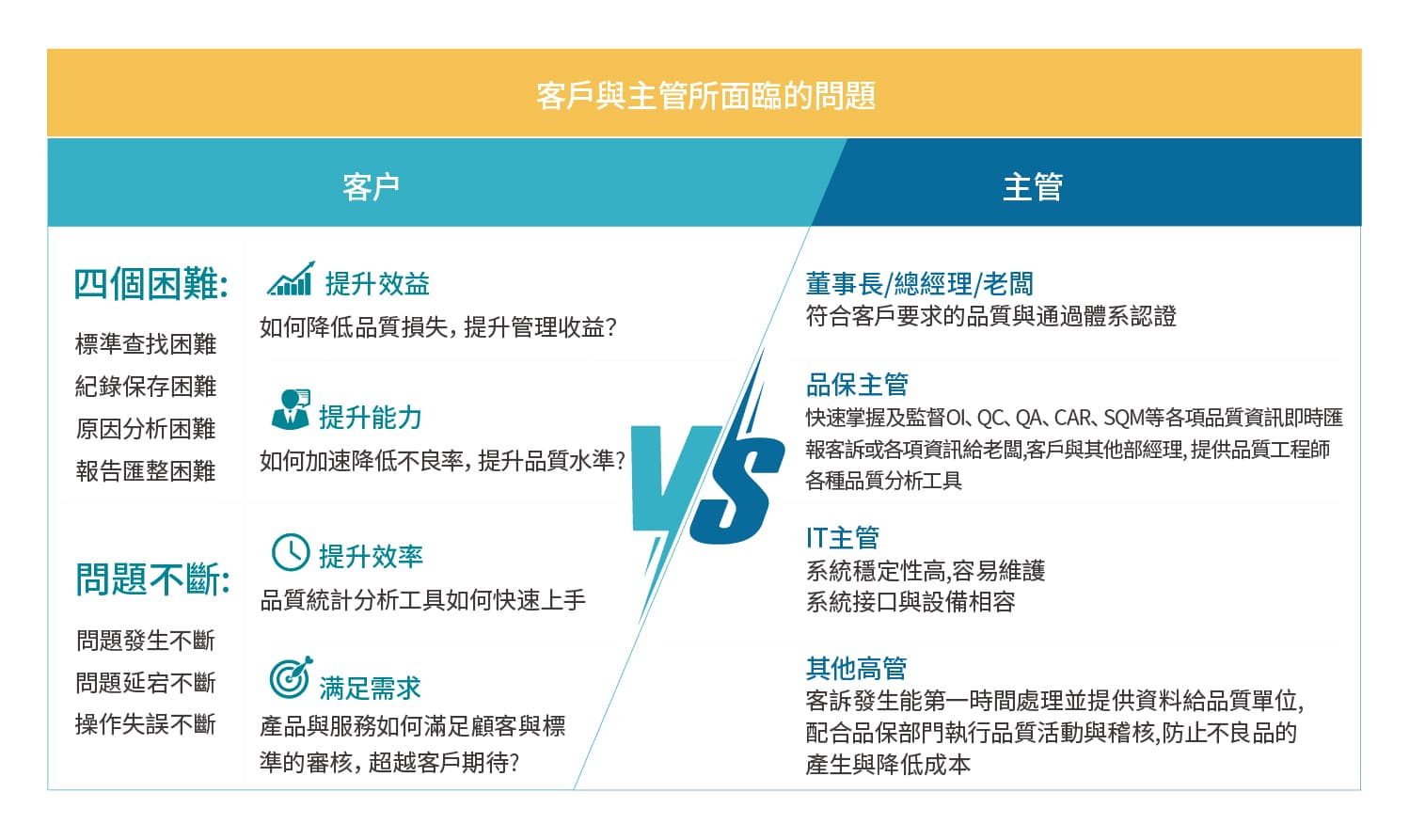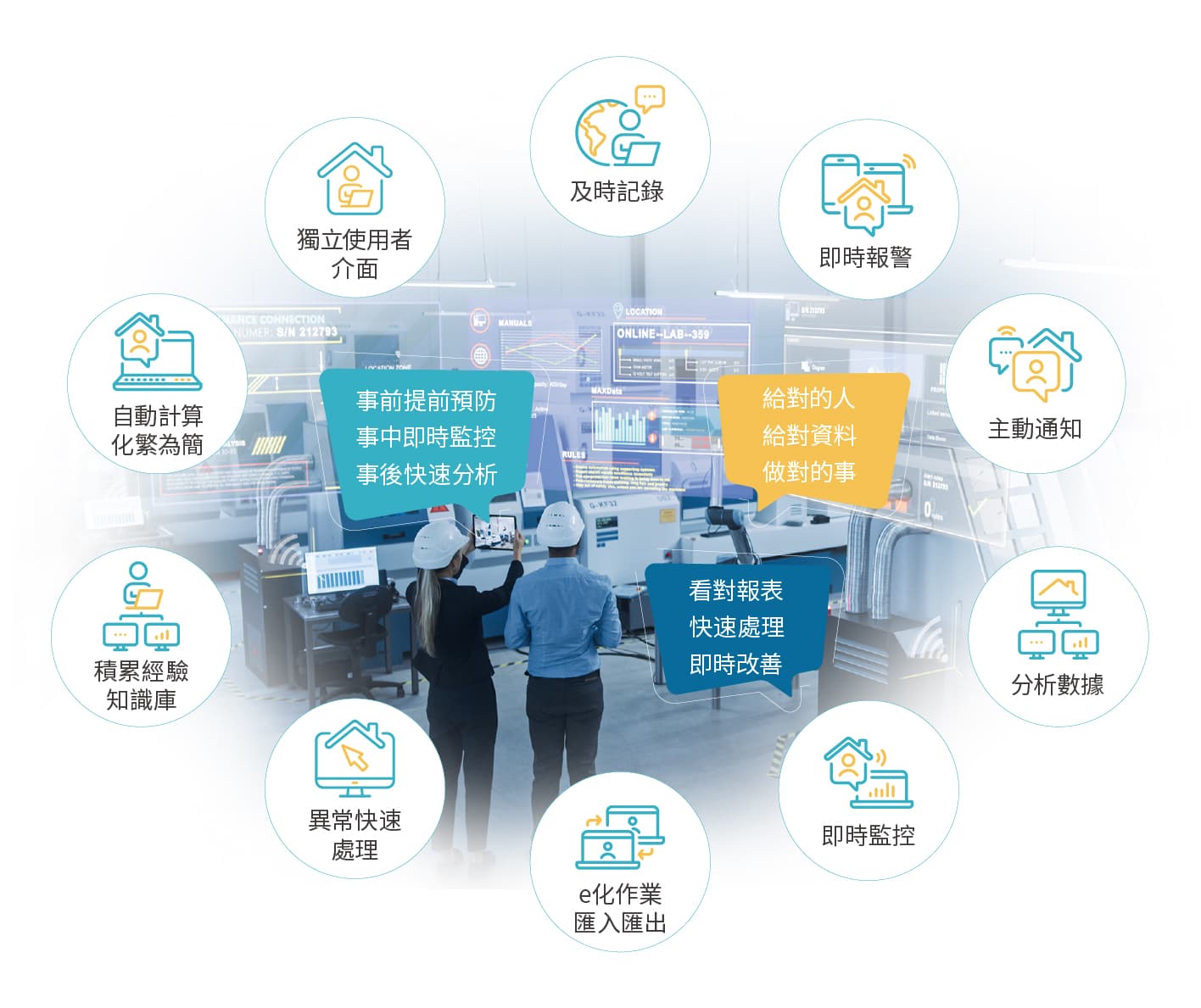


sQMS Smart Quality
Management System
Smart Quality Management System
With the advancement of technology and the rise of consumer quality awareness, government regulations on manufacturing industry have increased, leading to quality issues such as product rework, scrap, and recalls.
Since its proposal in 2013, Industry 4.0 has increased the complexity of production and smart manufacturing has become a global goal for the manufacturing industry. Digital transformation, automation, artificial intelligence (AI), machine learning, and other disruptive technologies are at the core of smart manufacturing. As the manufacturing industry adopts new digital technologies, quality management becomes increasingly important, and a supporting software system is needed for the quality management system.
Traditional quality systems are static and passive, and a dynamic and proactive approach is needed through smart quality to achieve the goal of zero defects and form a complete PDCA cycle.

sQMS Product Core Functions
Inspection Management
Independent user interface to ensure no pending tasks are overlooked
Correct inputs and outputs, and control of SIP versions to avoid misuse
Real-time recording of measurement and inspection data through mobile devices
Automatic triggering of document issuance in case of abnormal occurrences, and timely handling of exceptions
Complete records of inspection history for quick tracking of inspection details
One-click generation of inspection reports, supporting personalized report adjustments
Statistical Process Control (SPC)
Automatic drawing and interpretation of SPC control charts for real-time monitoring of process status
Simplification of complex process capability formulas through automated calculations
Deployment of 8D team analysis for in-depth investigation of root causes
Accumulation of abnormal knowledge base for quick querying of past problem-solving experiences.
Quality Analysis
Multi-dimensional problem analysis tool to identify key causes and provide targeted solutions
Use statistical analysis tools for prediction to assist in quality program decision making
Automatically calculate complex statistical formulas to generate analysis data and graphs with one click.
FMEA Management
Tree-like structure unfolding, logical guidance to establish FMEA
Plant a tree (structure tree), weave two nets (functional net/failure net)
Quickly import existing FMEA excel, data conversion is more convenient
MEA knowledge unified management, accumulated into dynamic experience knowledge base
Based on AIAG-VDA FMEA seven-step analysis process specification design
Support output of FMEA 4th and switch to 5th, reducing maintenance time.
MSA management
Quickly grasp the calibration records and conditions of each instrument
Follow the annual calibration plan to expand and proactively notify to avoid omissions
Measurement and counting analysis are designed based on AIAG specifications
Quickly view historical calibration reports and MSA reports
sQMS Product Features
Product Features:
Systematized inspection: SIP systematization establishes a complete and rigorous inspection criteria and process.
Real-time recording: solves the difficulty of real-time data collection and provides a basis for subsequent processing.
Real-time monitoring: timely identifies and alerts problems through SPC real-time control.
Real-time alarming: timely alarms and 8D abnormal processing, containing problems in the early stages and reducing problem severity.
Data analysis: in-depth and accurate analysis using QC seven quality tools.
Help solve root causes: provides guidance for problem-solving hypotheses and test design.
Prediction and improvement: comprehensive QA analysis to improve the level of quality management.
Structured process: FMEA uses a structure tree, function network, and failure network to establish a logical workflow for personnel.
Fast import/export: supports FMEA excel import and export, reducing personnel maintenance time.
Plan progress: sets up MSA instrument calibration plans to actively track and notify personnel to follow the plan.
Simplify complexity: the system automatically analyzes MSA’s judgment results for measuring and counting types, reducing personnel usage difficulty.
Product Benefit:
Simplified quality inspection process
One product, one number, one standard
Highly integrated system
System independence and rigor
Electronic inspection operation
Connectivity of instrument measurement data
Electronic inspection report, COA and one-click generation
Integrated inspection files to reduce human error
Electronic storage of data and knowledge base
Fast analysis
System actively notifies to avoid omissions
sQMS Application Case Studies
QMS Partial Case Clients - China

QMS helps reshape the standard by establishing granularity, ensuring one product, one code, one station, and one standard. This eliminates the need for manual selection of standards, increases the rigor of standards, and simplifies the inspection process. Furthermore, with a seamless system integration that bridges the gap between ERP/MES/QMS, internal quality information is rapidly communicated, enhancing the competitiveness of the company’s products.

The online implementation of QMS streamlines the entire process, including the integrated simplification of ERP-MES-QMS, achieving an 80% paperless quality process. The intuitive analysis and visualization of management charts and reports enhance the overall competitiveness and the ratio of intelligence within the group.

Based on the integrated design of enterprise information, the quality inspection and related content (QC) have transitioned from offline paper-based processes to an online and informational format. This realization of integrated quality information improves the efficiency of the quality inspection process and visualizes key quality control points.
QMS Partial Case Clients - Taiwan

By defining a Quality Control Plan and implementing SIP (Structured Improvement Program), the rigor of quality management is strengthened, leading to improved production quality yield and a reduction in failure costs. Simplifying complex inspection procedures enhances efficiency and lowers the operational costs of quality activities.

From the electronicization of basic inspection standards to the collection and recording of inspection data, ensuring that products are manufactured within standard ranges. The Statistical Process Control (SPC) process, which traditionally required a significant amount of manual maintenance, is streamlined through the SPC functionality in sQMS. This allows for real-time monitoring and rapid calculation of process capability indices to ensure the stability of the manufacturing process.

Meeting key requirements such as paperless inspection in enterprise factories, electronicization of SIP standards, handling of abnormal control, real-time monitoring of SPC control charts, and analysis of quality conditions. Through integrated integration of the standard central platform of ERP/MES/QMS, it strengthens collaboration within the quality department and enhances the overall competitiveness of the enterprise.



